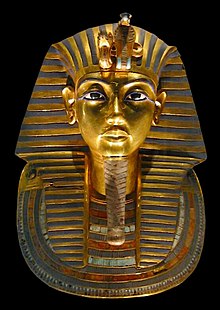Wiktionary英語版
出典:Wiktionary
ウィキペディア英語版
出典:Wikipedia
Tutankhamun
出典:『Wikipedia』 (2011/08/02 20:41 UTC 版)
英語による解説
- 引用
Tutankhamun (alternately spelled with Tutenkh-, -amen, -amon), Egyptian twt-ˤnḫ-ı͗mn, [təwaːt ʕaːnəx ʔaˈmaːn]; approx. 1341 BC – 1323 BC) was an Egyptian pharaoh of the 18th dynasty (ruled c.1333 BC – 1323 BC in the conventional chronology), during the period of Egyptian history known as the New Kingdom. His original name, Tutankhaten, means "Living Image of Aten", while Tutankhamun means "Living Image of Amun". In hieroglyphs, the name Tutankhamun was typically written Amen-tut-ankh, because of a scribal custom that placed a divine name at the beginning of a phrase to show appropriate reverence. He is possibly also the Nibhurrereya of the Amarna letters, and likely the 18th dynasty king 'Rathotis' who, according to Manetho, an ancient historian, had reigned for nine years — a figure which conforms with Flavius Josephus's version of Manetho's Epitome.
- Wiktionary
- Text is available under Creative Commons Attribution-ShareAlike (CC-BY-SA) and/or GNU Free Documentation License (GFDL).
Weblio英和・和英辞典に掲載されている「Wiktionary英語版」の記事は、WiktionaryのTutankhamun (改訂履歴)の記事を複製、再配布したものにあたり、Creative Commons Attribution-ShareAlike (CC-BY-SA)もしくはGNU Free Documentation Licenseというライセンスの下で提供されています。
- Wikipedia
- Text is available under Creative Commons Attribution-ShareAlike (CC-BY-SA) and/or GNU Free Documentation License (GFDL).
Weblio英和・和英辞典に掲載されている「Wikipedia英語版」の記事は、WikipediaのTutankhamun (改訂履歴)の記事を複製、再配布したものにあたり、Creative Commons Attribution-ShareAlike (CC-BY-SA)もしくはGNU Free Documentation Licenseというライセンスの下で提供されています。

